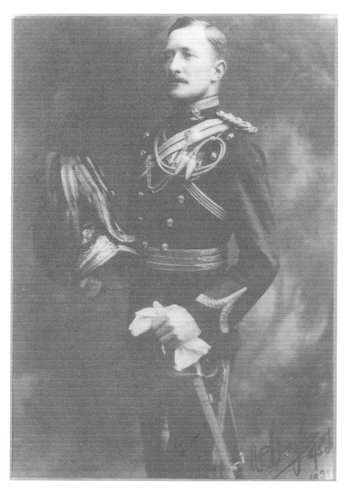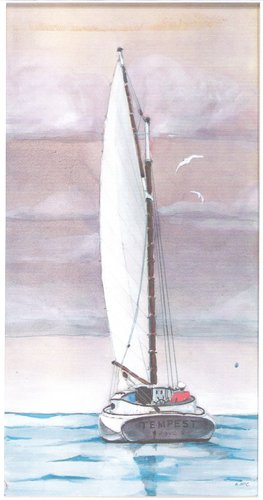By Jere Dennison & Temple Bayliss
Since our club's inception in 1939, all of our Commodores have enjoyed varied and distinctive backgrounds. However, none can boast the adventures of Major Bayliss who served as our Commodore in 1955; rather his life experiences would seem to be more closely aligned with those of Indiana Jones. Born in Britain in the waning years of the nineteenth century, he served his native country in two world wars.

During WWI, the Major, as he became later known, transferred from the Kingâ's cavalry into the Royal Air Corps as one of those daring young men in their flying machines and survived aerial combat in biplanes of wood and canvas. While his final wartime mission did not feature a dramatic dogfight with the notorious Red Baron, his damaged plane was forced to crash land into a German field gun behind enemy lines. Your Historian was recently loaned a book published in 1983 entitled Out in the Noonday Sun, a compilation of memoirs written by the Major before his death. A forward written by his son and current FBYC member, Temple Bayliss, perfectly encapsulates the Major's fascinating biography and is reprinted below with his permission and with very minor edits. The nearby photograph depicts the Major dressed for presentation to the King after being promoted to Captain in the British Army.
Born in Wolverhampton, in the Midlands of England in 1896, William Murray Forbes Bayliss was sent to public school ( Mill Meade followed by Shrewsbury) at the traditional age of eight. At Shrewsbury he took up racing rowing and won a prize for translating Tennysonâs "The Lotus Eaters" into Greek pentameter. On graduating at age eighteen he entered the Royal Military College, Sandhurst, to prepare for a career in the British Army. The desperate need for junior officers at the front in World War I led to his being commissioned at nineteen as a second lieutenant with the Fifth Lancers. He was sent into the trenches in 1916 and fought at the first battle of Somme, Arras, the second battle of Ypres, and at Cambrai before accepting an offer of transfer into the fledgling Royal Air Corps. Prohibited from being a pilot on the grounds that anyone who had been at the front for a year had had their nerves shattered, he flew as a gunner in Bristol fighters and as navigator and copilot in Handley Page bombers until he was shot down while flying at night over enemy territory in July, 1918. He was a prisoner of war until the collapse of Germany in December, 1918.
After the war he was assigned to the Northwest Frontier of British India (now the border of Pakistan and Afghanistan), where he fought with his regiment against Himalayan tribesmen raiding into British territory and continued to improve his horsemanship by playing polo and hunting wild boar with a spear. Temporary assignments carried him to Egypt where he was personal bodyguard to Lord Allenby, the British High Commissioner, and to Iraq where he was an acting Brigadier and Chief Instructor of Cavalry to King Faisal.
On a visit to relatives in Richmond in 1932, he met Catherine Murat Williams, his debutante third cousin. He returned to Virginia in the same year to marry her and plan a house in Goochland County (with a stable and kennel), which he built in 1939 (and named 'Fox Hill').
With the outbreak of the Second World War he returned to active duty in England as a Major but was reassigned to Jamaica where he was captain of the army polo team and editor of the service newspaper, the North Caribbean Star.
Returning to Virginia after the war, he founded the Goochland Gazette in 1955. He served as Master of Fox Hounds with the Deep Run Hunt Club for ten years and, in 1955, as Commodore of the Fishing Bay Yacht Club.

Temple expands on his fatherâ's sailing history at the club as follows, and nearby is watercolor image of the Major's 32-foot catboat rendered by 1951 Commodore Allan McCullough.
Dad joined FBYC around 1950 (age about 54). He bought a second hand Penguin named Willie and raced it with my mother as crew. After a year or so they were competent enough to win a little silver, but there were still capsizes and other incidents which I associate with being overage and overweight for dinghy sailing. They won the Piankatank Trophy in 1952.
Around 1955 he bought Tempest, a 32-foot catboat with a 12' 6" beam, that had been owned by the Grinnan family in Norfolk. She was built in 1907 and was feeling her age. I still remember a workman at Gene Ruark's yard saying, "I tell you, Gene, them cypress planks is still sound, it's the frames where the rot is." Hoisting the gaff was fun. Reefing with that 32-foot boom - which stuck out well aft of the counter - was something not to be forgotten. He raced her too, and she was fairly fast off the wind, but whatever silver he won was probably more for participation than actual boats beaten to the line.
###